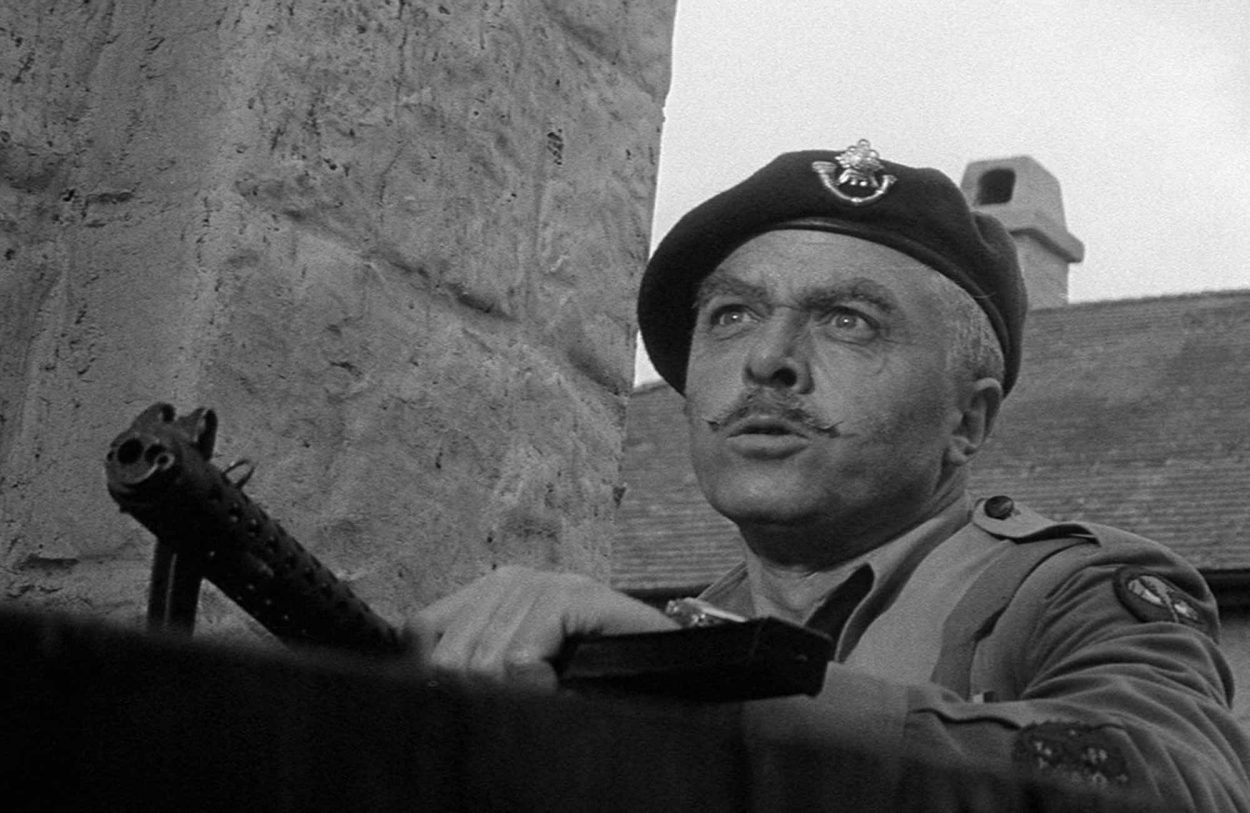In the early 1960s, numerous films were made about men with the power of X-ray vision, who invented or simply found X-ray glasses, or were gifted with sufficient imagination to see through women’s clothing. But only one film had the imagination to see through the blessing to the curse at its core: Roger Corman’s X (1963), whose forbidding title has become popularly augmented with the words The Man With the X-Ray Eyes.
The idea may have come from American International Pictures producer James H. Nicholson, or from Corman himself, but the story and script were principally the work of Chicago-born pulp scribe Ray Russell. In the late 1950s, Russell had been chosen by publisher Hugh M. Hefner to become the Senior Fiction Editor at Playboy, which introduced his work to a whole new audience. It was Playboy that published his novella Sardonicus, filmed by William Castle in 1961 as Mr. Sardonicus – a breakthrough into screenwriting that was quickly followed by an adaptation of Edgar Allan Poe’s The Premature Burial (1962) for Corman. (The X script is co-signed by Robert Dillon, whose work on the project was bookended by two other Castle productions: 13 Frightened Girls and The Old Dark House, both 1963.) In some ways, X might seem a more natural project for William Castle – X-ray vision, the possibility of titillation; these ideas lend themselves to flourishes of Castle-like gimmickry. Indeed, X was initially released in “the new photographic process Spectarama” – a process that, like many others, had less to do with advances in cinematography than with luring gullible folks of all ages into theaters by the thousands.
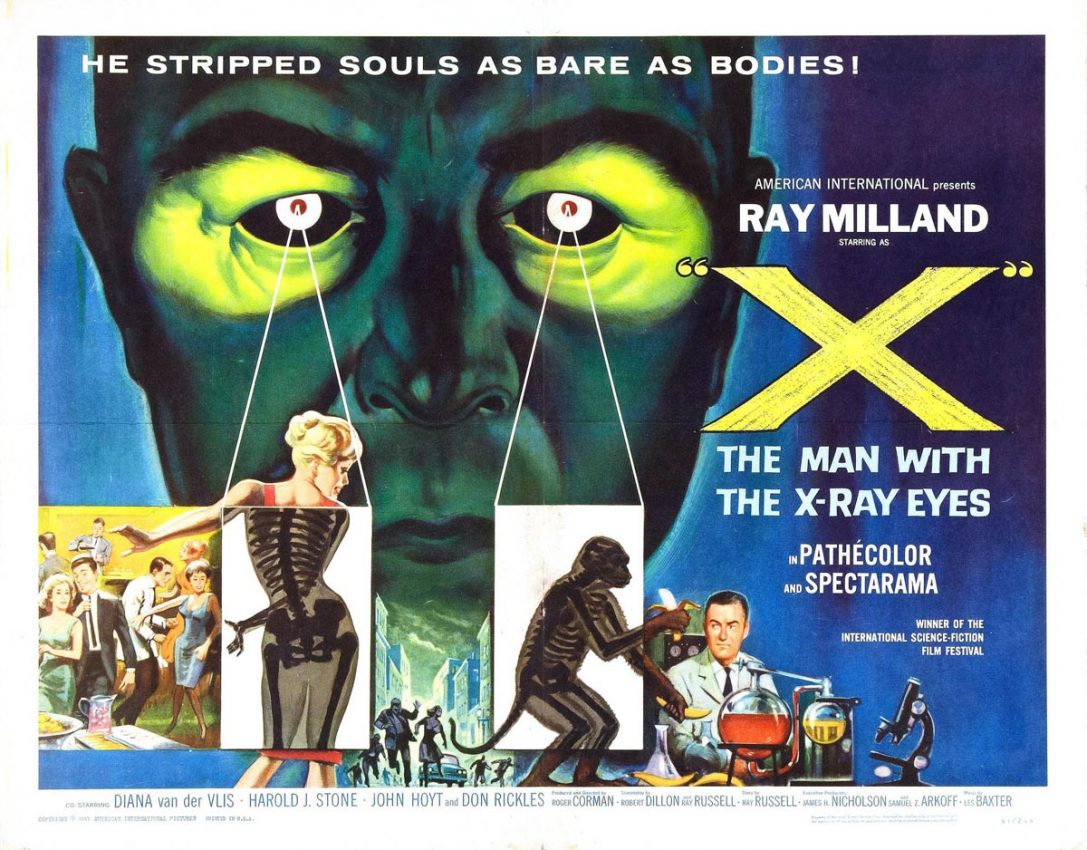
Russell must have known that similar ideas had abounded in the pulp magazines of his youth. In the early 1930s, Ohio-born pulp writer Edmond Hamilton wrote a story entitled “The Man Who Saw Everything,” which appeared in the magazine Startling Stories under the title “The Man With X-Ray Eyes.” It’s the story of a young and ambitious newspaper reporter who volunteers to become a human test subject for an experimental X-ray vision fluid. It’s a risky procedure but his reasons for participating are both noble and wholesome: as a newspaper reporter, he craves the ability to “see through anything” – to the truth; he’s also in love with a nice girl, and wants to become successful enough at his job to be able to buy her a ring. The story was subsequently collected in Hamilton’s 1936 anthology The Horror on the Asteroid and Other Tales of Planetary Horror. Two years later, in Action Comics #11, another reporter – Clark Kent, a.k.a. Superman – suddenly acquired the power to see through solid objects. Advertisements for X-ray glasses then began to appear in pulp and comic magazines alike, an accompanying graphic turning their power on a pretty girl.
Though Hamilton was the husband of legendary screenwriter and novelist Leigh Brackett (The Big Sleep, Rio Bravo, The Empire Strikes Back), somehow his highly potent cinematic idea didn’t become the crux of an actual screen story until 1959, when a former combat photographer (also associated with Playboy) finally recognized its potential. Russ Meyer’s The Immoral Mr. Teas (1959) told the very thin story of a man who awakens after being anaesthetized for dental surgery with a talent for seeing through women’s clothing. Produced for a mere $24,000, the film made Meyer a millionaire – the very definition of an American movie maverick. For the next several years, almost every other movie tagged “Adults Only” seemed to have some form of silly X-ray vision fantasy attached.
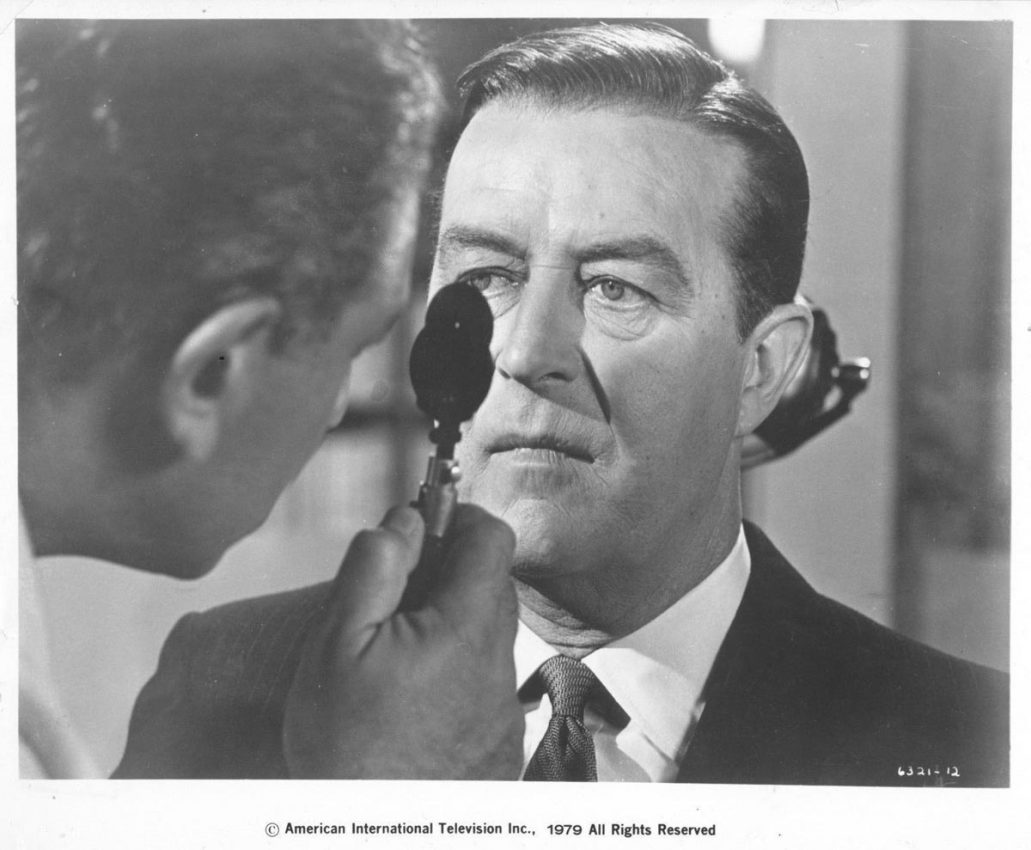
Before X and for years to follow, vision would stand out as one of the cornerstone interests of Roger Corman’s filmography. Paul Birch in Not Of This Earth (1956), Vincent Price in The House of Usher (1960) and The Tomb of Ligeia (1965), Peter Fonda in The Wild Angels (1966) and The Trip (1967) and, of course, Ray Milland in X – four of these six hyper-sensitive protagonists hide their eyes behind dark glasses. As Corman admitted to authors Alain Silver and James Ursini in their book Roger Corman – Metaphysics on a Shoestring, “The concept of a character with sensitive vision is in several of my films. I don’t know where my fascination is rooted, but it is clear that I have come back to it over and over again… Someone asked me, when I was a child, if I had to choose between blindness and deafness, which would it be? I immediately said deafness, frightening as either prospect would be to a child. And, fortunately, the fact that I work in motion pictures, which are a visual medium, supports my fascination with sight.”
Corman has traced these persistent concerns to a boyhood Christmas gift, presented to him by his parents, of the Collected Works of Edgar Allan Poe. Sensory sensitivity is common in Poe, from Roderick Usher (whose hypersensitive hearing can hear the rats in the walls of his crumbling house) to the nameless narrator of “The Tell Tale Heart” (who is driven to madness and confession by the retained sound of his murder victim’s beating heart), but there is also in Poe a horror of whiteness, of blindness, which is found in Poe’s only novel, The Narrative of Arthur Gordon Pym of Nantucket, first published in July of 1838. It’s a tale of shipbound misadventure that concludes with its protagonist bound toward ever whitening vistas as he nears the final isolation of the South Pole. Pym’s nightmarish plight is comparable, and may well have been inspired, by the plight of the Creature in Mary Shelley’s 1818 novel Frankenstein – a literary subject that Corman would explore in his final directorial effort to date, Frankenstein Unbound (1990). Furthermore, X gains still more centrality in Corman’s filmography for its depiction of chemically-induced visions and insights, which looks ahead to his seminal 1967 LSD film, The Trip.
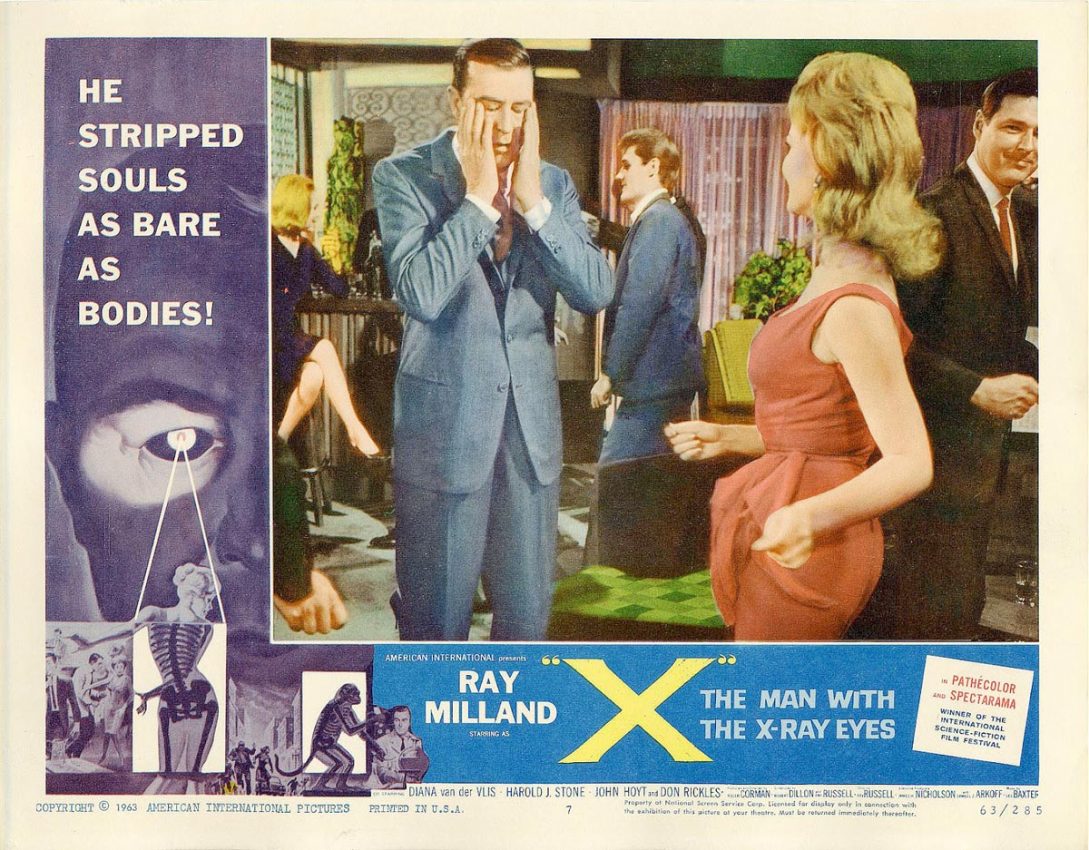
X is the story of Dr. James Xavier (Milland), who develops a chemical that, once dropped into the eye, helps to “peel back” the layers of the reality we accept from the larger reality lurking behind. Because Xavier is committed to science, his research results in an addiction – not to the fluid, but to the capital T truth that shows a bit more of its hem each time he self-administers. His quest redefines him, degrading him outwardly while elevating him inwardly; we see him run the gamut from respected doctor to fugitive from justice, from carnival attraction to bowery Buddha, from desolate wanderer to visionary.
Early in X, Xavier’s colleague Dr. Sam Brandt (Harold J. Stone) confirms to him something he must already know, which the audience probably doesn’t: that the luminous wavelengths available to human sight are limited to between 4,000 and 7,800 axiom units, a mere 1/10th of the actual wave spectrum. (These numbers differ from those in Dillon’s draft of the script, so who really knows or cares? True or not, it sounds good.)
“What could we see, if we could see the other 90 per cent?” Xavier ponders, rising to pace the room like a caged animal, as if it is the 10% (not the 90) holding him back. When Brandt reasons that only the Gods see everything, Xavier boasts that he’s “closing in on the Gods.”
This line performs the function of relating Xavier’s quest – before we even know what it is – to the pursuits of other blaspheming mad scientists in the cinema who have presumed to meddle in things Man is meant to leave alone. At the same time, it foreshadows the ultimately transcendental bent of Xavier’s quest: he’s as much a poet or philosopher as a physician; what he is closing in on is a chemical that, once introduced into the eye, will intensify his gaze and elevate him to new levels of experience and, hopefully, understanding. He wants to peel back reality and see what eternity is – but he makes the mistake of equating his own insatiable curiosity with an ability to handle the immensity of the answers. In believing that he is closing in on God, Xavier has not paused to consider that God may be closing in on him.
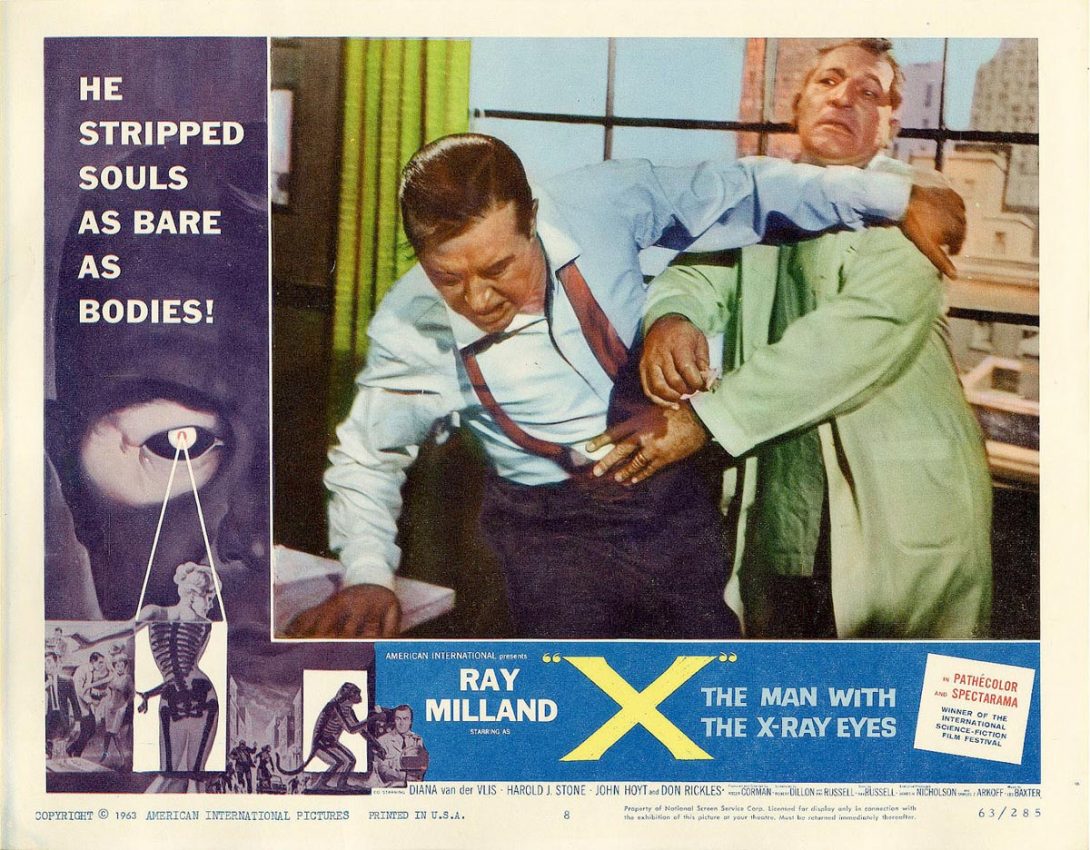
The terrible light that resides at the heart of Xavier’s fears – as he undergoes his feature-length transformation from, is the very basis of all cinema. X was made to be projected onto large screens by beacons of light, and watching it on Blu-ray or DVD or television – no matter how good your set-up – is not quite the same as seeing this film on the big screen, where it occasionally plucks you out of darkness to plunge you into auroras of blinding light.
Corman had previously worked with Ray Milland in one of his Poe pictures, Premature Burial (1962), but his casting in X – while probably principally convenient – carries a post-modernist charge. Corman uses Milland as much for the sake of his associations as his fine performance (Milland himself considered it one of his best), much as Jean-Luc Godard would subsequently use Eddie Constantine and his Lemmy Caution character in Alphaville (1965). Milland’s career as a debonair leading man had peaked in 1945 with Billy Wilder’s The Lost Weekend, in which he played Don Birnham, an alcoholic writer subject to nightmarish hallucinations. The role won him the Academy Award for Best Performance by an Actor. Like Birnam, a writer who believes he can only improve on his past work by writing drunk, James Xavier is a visionary who believes that his only means of vaulting beyond his own conceptual limitations is to push himself to the brink of oblivion. Birnham is addicted to hooch, but Xavier is addicted to truth, determined to discover something that will make him immortal – even if it kills him. Another relevant highlight of Milland’s career was the 1952 film The Thief, directed by Russell Rouse. It was the first motion picture of the sound era to be filmed entirely without dialogue – placing its entire emphasis on sight. Though it’s hardly an Academy Award, it’s worth pointing out that X was presented with the first Golden Spaceship Award (for Best Picture) at the 1963 Trieste Science Fiction Film Festival.
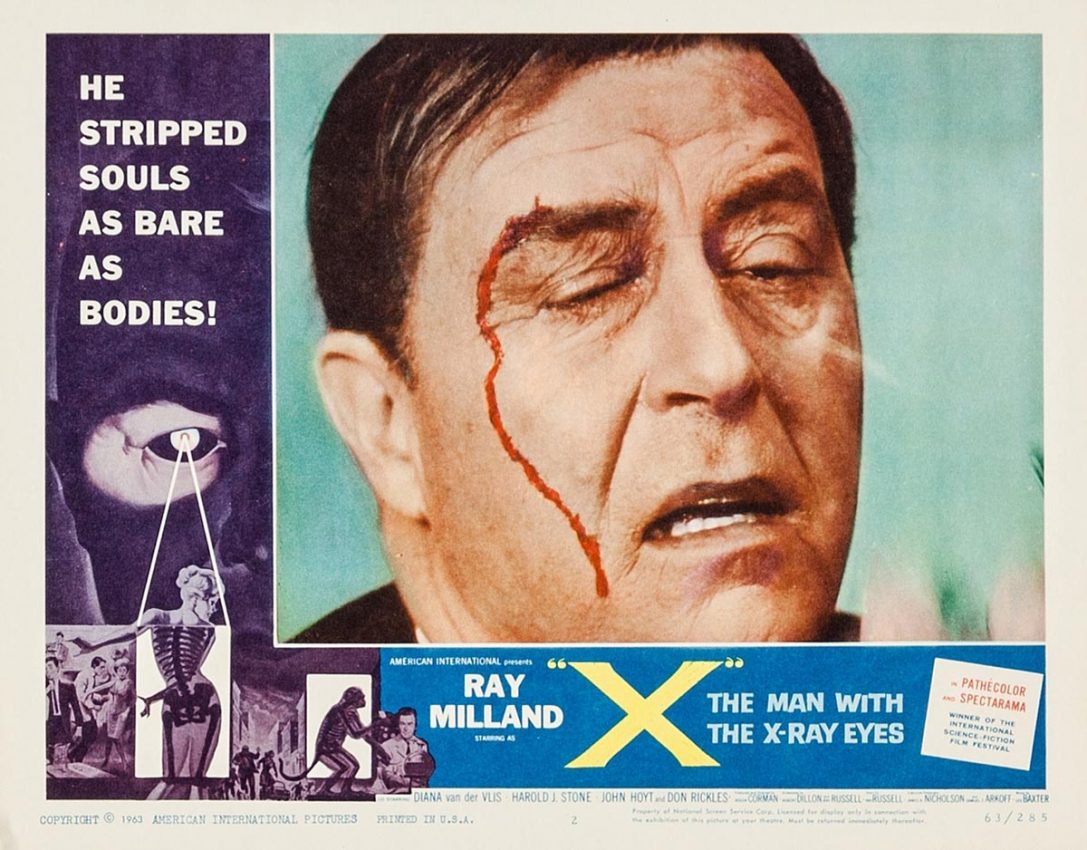
In Roger Corman: The Millennic Vision, published to coincide with a retrospective of Corman’s work at the 1970 Edinburgh Film Festival, Paul Willemen writes admirably about the film’s climactic chase: “Xavier’s growing personal isolation is paralleled by his increased geographical isolation, until we see him driving through the desert, trying to escape from what can only be called God’s punishment for his hubris. The pictorial realisation of the vengeful god is reminiscent of Bergman’s spider in Through a Glass Darkly. Here it takes the form of a helicopter hovering over Xavier’s car.”
If we go back and look at Through a Glass Darkly, it is the confluence of the spider emerging from the wall and the arrival of a rescue helicopter at the height of Harriet Andersson’s nervous breakdown that causes her to exclaim that “God is a spider!” Writing in the pre-video days, Willemen didn’t have handy access to his point of reference, but his comparison is more apt than he may have realized. It may well have been a conscious touch, too, as Corman cited Bergman as his favorite director and Through a Glass Darkly would have been, at the time X went into production, his most recent release.
Karin, the principal character of this Bergman film, becomes still more conspicuously akin to Xavier if we go back to examine her story arc. She is a young woman recently released from the hospital where she was treated for schizophrenia. Transplanted from the attentive hospital back into the environment of her family, particularly her remote and uncaring father, traces of her mental illness begin to return – she tells her brother that God is coming for her, that she is waiting for him to appear behind the wallpaper – implying that she has the ability to see through it. After maliciously seducing and thus contaminating her younger brother, she agrees to return to the hospital, and passes the time for the arrival of her transport by gazing at a crack in the wall, from which a spider emerges. “I have seen God,” she says, shattered – much as James Xavier says in the last minutes of X, when he moves beyond the earthly concerns of sex and money to the ultimate truth that awaits us all – decades after he sat, transfixed and horrified, by the sight of a bat emerging from a crack in his living room wall in The Lost Weekend. He too has seen God and, as it was with Karin, the illumination is unbearable.
Roger Corman’s X will be playing twice at the New Beverly Cinema, on (Friday) June 23 and (Saturday) June 24, both nights at 7:30pm.
© 2017 by Tim Lucas. All rights reserved.


